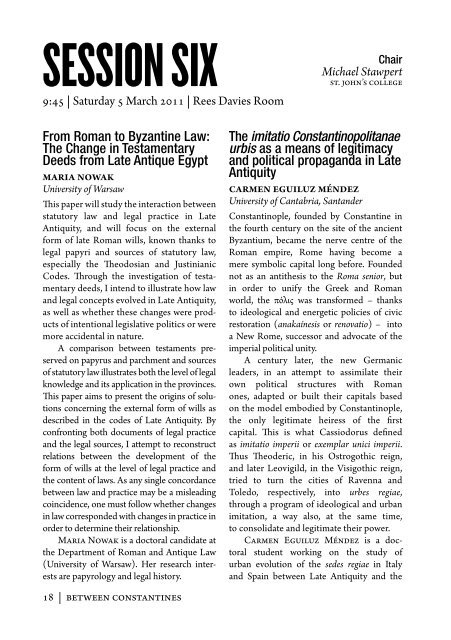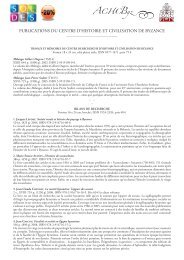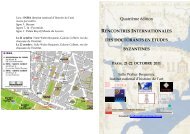booklet of abstracts - Oxford University Byzantine Society
booklet of abstracts - Oxford University Byzantine Society
booklet of abstracts - Oxford University Byzantine Society
Create successful ePaper yourself
Turn your PDF publications into a flip-book with our unique Google optimized e-Paper software.
Session six9:45 | Saturday 5 March 2011 | Rees Davies RoomChairMichael Stawpertst. John’s CollegeFrom Roman to <strong>Byzantine</strong> Law:The Change in TestamentaryDeeds from Late Antique EgyptMaria Nowak<strong>University</strong> <strong>of</strong> WarsawThis paper will study the interaction betweenstatutory law and legal practice in LateAntiquity, and will focus on the externalform <strong>of</strong> late Roman wills, known thanks tolegal papyri and sources <strong>of</strong> statutory law,especially the Theodosian and JustinianicCodes. Through the investigation <strong>of</strong> testamentarydeeds, I intend to illustrate how lawand legal concepts evolved in Late Antiquity,as well as whether these changes were products<strong>of</strong> intentional legislative politics or weremore accidental in nature.A comparison between testaments preservedon papyrus and parchment and sources<strong>of</strong> statutory law illustrates both the level <strong>of</strong> legalknowledge and its application in the provinces.This paper aims to present the origins <strong>of</strong> solutionsconcerning the external form <strong>of</strong> wills asdescribed in the codes <strong>of</strong> Late Antiquity. Byconfronting both documents <strong>of</strong> legal practiceand the legal sources, I attempt to reconstructrelations between the development <strong>of</strong> theform <strong>of</strong> wills at the level <strong>of</strong> legal practice andthe content <strong>of</strong> laws. As any single concordancebetween law and practice may be a misleadingcoincidence, one must follow whether changesin law corresponded with changes in practice inorder to determine their relationship.Maria Nowak is a doctoral candidate atthe Department <strong>of</strong> Roman and Antique Law(<strong>University</strong> <strong>of</strong> Warsaw). Her research interestsare papyrology and legal history.The imitatio Constantinopolitanaeurbis as a means <strong>of</strong> legitimacyand political propaganda in LateAntiquityCarmen Eguiluz Méndez<strong>University</strong> <strong>of</strong> Cantabria, SantanderConstantinople, founded by Constantine inthe fourth century on the site <strong>of</strong> the ancientByzantium, became the nerve centre <strong>of</strong> theRoman empire, Rome having become amere symbolic capital long before. Foundednot as an antithesis to the Roma senior, butin order to unify the Greek and Romanworld, the πόλις was transformed – thanksto ideological and energetic policies <strong>of</strong> civicrestoration (anakaínesis or renovatio) – intoa New Rome, successor and advocate <strong>of</strong> theimperial political unity.A century later, the new Germanicleaders, in an attempt to assimilate theirown political structures with Romanones, adapted or built their capitals basedon the model embodied by Constantinople,the only legitimate heiress <strong>of</strong> the firstcapital. This is what Cassiodorus definedas imitatio imperii or exemplar unici imperii.Thus Theoderic, in his Ostrogothic reign,and later Leovigild, in the Visigothic reign,tried to turn the cities <strong>of</strong> Ravenna andToledo, respectively, into urbes regiae,through a program <strong>of</strong> ideological and urbanimitation, a way also, at the same time,to consolidate and legitimate their power.Carmen Eguiluz Méndez is a doctoralstudent working on the study <strong>of</strong>urban evolution <strong>of</strong> the sedes regiae in Italyand Spain between Late Antiquity and the18 | Between Constantines





